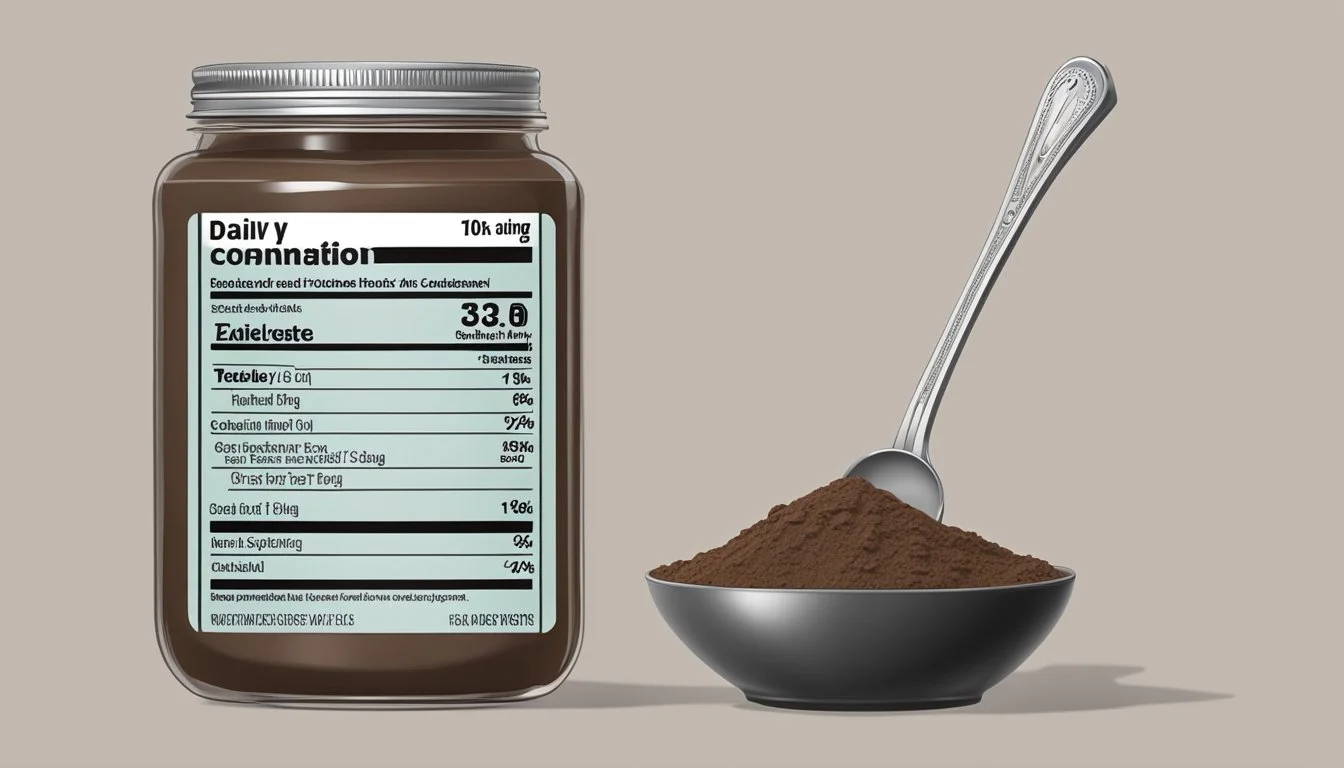How Much Hershey's Cocoa Powder Per Day Is Too Much?
Understanding Safe Limits
Consuming Hershey's cocoa powder has become a popular way to enjoy chocolate's (What wine goes well with chocolate?) rich flavors while reaping potential health benefits. Cocoa powder is known to contain nutrients such as iron, zinc, selenium, and magnesium and offers a way to enjoy chocolate without the high sugar and fat content of traditional chocolate bars. Hershey's cocoa powder, in particular, is processed with a minimalist approach to maintain the purity and nutritional content of the cocoa.
Knowing the right amount of cocoa powder to consume daily is essential for maintaining a balanced diet. While a quarter-cup serving of unsweetened cocoa powder contains only 49 calories, moderation is key. Overconsumption of any food product, regardless of its health benefits, can lead to unintended nutritional imbalances or excessive calorie intake.
The advised daily intake of Hershey's cocoa powder is not established due to variations in individual dietary needs and existing health considerations. However, it is important to consider that flavonoids, the compounds associated with lowering blood pressure and other health advantages, can be found in cocoa powder. Consumers should integrate cocoa powder into their diets with attention to overall nutritional guidelines and personal health objectives.
Cocoa Powder Overview
Cocoa powder, derived from Theobroma cacao beans, is a fundamental ingredient in chocolate production. The process involves fermenting, drying, and roasting the cacao beans, followed by cracking them into nibs. The nibs are then ground into a paste, known as chocolate liquor, from which cocoa butter is extracted, leaving behind the dry cocoa solids that are finely ground to form cocoa powder.
Types of Cocoa Products
Unsweetened Cocoa Powder: Utilized in baking and cooking, offering a rich flavor without added sugar.
Cacao Powder: Similar to unsweetened cocoa powder but less processed, retaining more of the beans' natural nutrients.
Cocoa Butter: A byproduct used to give chocolate its smooth texture.
Milk Chocolate: Combines cocoa products with milk and sugar.
Dark Chocolate: Contains higher cocoa content and less sugar than milk chocolate.
Cocoa powder, whether in its less processed form of cacao powder or as unsweetened cocoa powder, is renowned for its nutritional value. It is fibrous, mineral-rich, and contains flavonoids, which have been linked to various health benefits.
Hershey's cocoa powder is known for its minimalist approach to processing, which aims to preserve as much of these nutrients as possible. While Hershey's boasts a 100% pure product in their natural unsweetened cocoa, consumers are increasingly concerned with the nutritional value preserved in cocoa powder after processing.
When incorporating cocoa powder into a daily diet, moderation is key. The exact amount that constitutes too much may vary by individual, taking into account factors like overall daily caloric and nutrient intake, as well as personal dietary restrictions or goals.
Nutritional Content
The nutritional profile of Hershey's cocoa powder is notable for its low calorie count alongside a significant amount of fiber and minerals. It's a rich source of various phytochemicals, including flavanols.
Caloric Information
A quarter cup of unsweetened Hershey's cocoa powder contains approximately 49 calories. This low caloric value makes it a preferred option for those who are calorie conscious.
Vitamins and Minerals
Cocoa powder, including Hershey's brand, comes packed with a spectrum of essential minerals. A detailed breakdown is as follows:
Iron: Contributing to red blood cell production, it aids in oxygen transport.
Magnesium: Supports muscle and nerve function and energy production.
Zinc: Vital for immune system function.
Selenium: Plays a crucial role in metabolism and thyroid function.
Copper: Necessary for iron metabolism and the formation of red blood cells.
Phosphorus: Assists in the formation of bones and teeth.
Potassium: Helps to regulate fluid balance and muscle contractions.
Phytochemicals in Cocoa
Hershey's cocoa powder contains a variety of phytochemicals:
Flavanols: These antioxidants can support heart health by improving blood flow and reducing blood pressure.
Polyphenols: Associated with various health benefits, including reduced inflammation.
Theobromine: A mild stimulant that can provide a boost in energy and mood.
Flavonoids: They have antioxidant properties and may contribute to the maintenance of good health.
Each of these compounds offers unique benefits, making cocoa powder more than just a flavorful addition to foods and beverages.
Health Benefits
Cocoa powder, a product derived from cocoa beans, has been associated with various health benefits, primarily due to its high content of antioxidants, including flavanols and polyphenols. These compounds contribute to a range of protective effects on the human body, from improving cardiovascular health to potentially reducing cancer risk.
Cardiovascular Health
Regular consumption of cocoa flavanols has been linked to a decrease in blood pressure. Investigations suggest that these compounds help dilate blood vessels, which can lead to improved blood flow and a lower risk of heart disease. Furthermore, cocoa powder can influence cholesterol levels by reducing LDL (bad) cholesterol and potentially increasing HDL (good) cholesterol, contributing to overall cardiovascular health.
Metabolic Effects
Cocoa powder's influence on metabolism is noteworthy. The theobromine in cocoa has a mild stimulant effect, which may aid in weight loss and blood sugar control. Moreover, the flavonoids found in cocoa can improve insulin sensitivity, reducing the risk of diabetes. These metabolic effects underline cocoa's role in maintaining a balanced internal system.
Brain Health and Mood
Cocoa contains compounds that can enhance brain function and mood. The flavonoids in cocoa are believed to improve cognitive performance and attention by augmenting blood flow to the brain. Additionally, consuming cocoa powder can lead to the release of endorphins, thereby positively impacting one's mood.
Cancer Prevention
Cocoa powder is rich in antioxidants that protect cells from damage by free radicals, potentially reducing the risk of cancer. The presence of polyphenols has been associated with a lower risk of certain cancers like colon cancer. These antioxidants may assist in preventing the inflammatory processes that can lead to tumor growth.
Potential Risks and Side Effects
While Hershey's cocoa powder can be a delicious addition to various recipes, it is important to consider the potential risks and side effects associated with its consumption. These may vary from allergic reactions to impacts on cardiovascular health and blood sugar levels, as well as concerns about cadmium content.
Allergy and Sensitivity
Individuals with certain allergies may experience adverse immune responses to cocoa powder. Symptoms can vary from mild skin irritations to more severe allergic reactions that require immediate medical attention.
Cardiovascular Risks
Excessive consumption of cocoa powder may influence cholesterol levels and blood pressure. While cocoa has been associated with cardiovascular benefits in moderation, too much can lead to negative effects.
Effects on Blood Sugar
Cocoa powder has a moderate impact on blood sugar levels. It’s crucial for those with diabetes or on insulin to monitor their intake to avoid any potential spikes or disruptions in their blood sugar levels.
Cadmium Content Concerns
Cocoa beans can absorb heavy metals like cadmium from the soil during their growth. This metal can find its way into cocoa powders during processing. High intake of cadmium over time is linked with several health risks, and recent tests have resulted in concerns over the levels found in some chocolate products, including certain Hershey's Cocoa Powder batches.
Recommended Daily Intake
When considering the inclusion of Hershey's cocoa powder in the diet, it is essential to understand the recommended daily intake. Nutrition guidelines do not provide a specific amount for cocoa powder consumption, but moderate use in the context of a balanced diet is suggested to harness its health benefits while mitigating risks.
Cocoa is rich in flavonoids, and these compounds are linked to health benefits, such as improvement in cardiovascular health. However, the calorie and fat content in cocoa powder should be taken into account. Unsweetened Hershey's cocoa powder contains approximately 49 calories and 0.74 grams of fat per quarter-cup serving.
Nutrient Content per Quarter Cup:
Calories: 49
Fat: 0.74 grams
In the context of disease prevention, moderate cocoa consumption might reduce the risk of certain diseases due to its flavonoid content. However, excessive intake can lead to side effects, possibly affecting individuals with existing health conditions.
There are no standardized guidelines for maximum daily intake, but extrapolating from European Union recommendations of 2.5 micrograms of cadmium per kilogram of body weight per week can be a starting point for caution. This limit correlates with concerns over heavy metals sometimes present in chocolate products, including cocoa powder.
In summary, Hershey's cocoa powder can be incorporated into a healthy diet in moderate amounts. Individuals should consider their total daily caloric and fat intake when calculating how much cocoa powder to consume. Ongoing research may provide more detailed recommendations in the future.
Consumption Tips and Best Practices
In approaching cocoa consumption, particularly with Hershey's cocoa powder, it is pivotal to understand how to integrate the ingredient into a diet, select the best quality, and balance intake for optimal health benefits.
Using Cocoa in Foods
Cocoa powder can be a versatile addition to various foods. Unsweetened cocoa powder contains minimal calories and is a good source of iron and magnesium. To satisfy a sweet tooth while maintaining health benefits, consider adding it to beverages like hot chocolate or smoothies, or incorporating it into recipes for a rich flavor. For a less bitter taste, it can be balanced with natural sweeteners or combined with fruit, peanut butter, or yogurt.
Hot Chocolate: Mix unsweetened cocoa powder with a sweetener of your choice and warm milk or a milk alternative.
Smoothies: Add a tablespoon of cocoa powder to your berry or banana smoothie for an antioxidant boost.
Baked Goods: Replace processed chocolate bars with cocoa powder in recipes for cakes, brownies, or cookies.
Choosing Quality Cocoa
Selecting high-quality cocoa powder is crucial for both flavor and health. Opt for brands that source fermented, non-alkali processed cocoa beans, which are usually roasted to enhance flavor and preserve nutritional value. Premium cocoa often comes from regions like South America or Europe where the beans undergo careful processing to retain flavonoids—compounds associated with several health benefits, such as improved blood vessel function.
Non-alkali Processed: Look for cocoa powders that are not processed with alkali as this can reduce flavonoid content.
Origin Label: Check for details about bean origin; cocoa from renowned regions can be a marker for quality.
Ingredient List: The shorter the list, generally, the less processed the cocoa powder is.
Balance and Moderation
While cocoa powder can be a healthy choice, moderation is key due to its caloric content which can add up, particularly if combined with high-calorie mix-ins or sweeteners. It's advisable to limit daily intake to a few tablespoons to reap the health benefits without overconsumption of calories, fats, or sugars. For instance, Hershey's cocoa powder should be consumed in moderation, as excessive amounts may lead to intake of substances like cadmium.
Daily Limit: Aim for no more than 2 tablespoons of cocoa powder per day to manage calorie intake and potential heavy metal exposure.
Nutritional Balance: Combine cocoa with other nutrient-dense foods like nuts, seeds, and whole grains to achieve a balanced diet.
Health Goals: Consider personal dietary needs and consult with a healthcare provider if you have concerns about adding cocoa to your diet.
Historical and Cultural Context
The journey of cocoa from a treasured fruit to a global culinary staple is rich with historical significance and cultural practices. This section explores its origins, trade development, and the traditions that have shaped its consumption.
Origins of Cocoa Consumption
Cocoa's roots can be traced back to the ancient civilizations of South America. The Mayans revered cacao beans as a gift from the gods, using them not only as a form of currency but also to create a ritual beverage. This early form of hot chocolate was a far cry from the sweetened versions known in Europe today; it was a bitter mixture often combined with spices or corn puree. Similarly, the Aztecs valued cocoa for both its economic significance and its use in creating xocolatl, a preparation that included ground cacao beans mixed with water and other ingredients.
Cocoa Trade and Industry Development
The trade of cocoa beans initiated a massive shift in consumption as it reached European shores. Post-15th century, after European contact with South America, cocoa became an exotic luxury in Europe. Over time, European innovation led to the development of processes that transformed cocoa into various forms, such as cocoa powder and chocolate bars. Brands like Hershey's began to emerge, further industrializing chocolate production and making products like milk chocolate widely accessible.
Cultural Associations and Traditions
In various cultures, cocoa and chocolate have become synonymous with certain traditions and social practices. For example, hot chocolate is a popular beverage during the winter season in many Western societies, often associated with comfort and familial gatherings. Chocolate also plays a central role in celebrations: it's a common gift on Valentine's Day, symbolizing affection and love. Chocolate bars and various chocolate-infused foods have woven themselves into the fabric of cultural customs and personal indulgences around the world.
Conclusion
Cocoa powder is favored for its rich flavor and health benefits, chiefly due to the presence of antioxidants. Hershey's Cocoa Powder has found its way into many households as a key ingredient in a variety of recipes. However, recent tests have raised concerns about lead levels in these products.
Consumers should be mindful of their recommended intake of cocoa powder. While no universal guideline exists for the "safe" amount of Hershey's cocoa powder specifically, it is essential to consider California’s lead limits, which suggest a maximum of 0.5 micrograms per day from cocoa products. One tablespoon of Hershey's Cocoa Naturally Unsweetened has been reported to exceed this limit by 25%.
Incorporating cocoa powder into a balanced diet is still possible, considering these findings. Hershey's cocoa powders can still be consumed in moderation, but it is recommended to be vigilant about the quantities used especially in light of recent lead content concerns. Consumers may choose to balance their intake of such products with other nutrient-rich foods that contribute to overall well-being. It is advisable to consult with healthcare providers for personalized dietary recommendations.
In summary, while cocoa powder can offer health benefits, responsible consumption is advised. Given the concerns about heavy metals in certain products, staying informed and cautious with portion sizes becomes particularly important.










